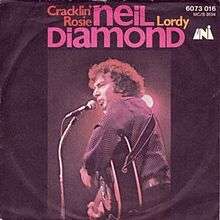Cracklin' Rosie
"Cracklin' Rosie" is a song written and recorded by Neil Diamond in 1970, with instrumental backing by L.A. session musicians from the Wrecking Crew,[1] including Hal Blaine on drums, Larry Knechtel on keyboards, Joe Osborn on bass, Al Casey on guitar and Gene Estes on percussion – arranged by Don Randi. The song was included on Diamond's album Tap Root Manuscript. In October 1970[2] the song became Diamond's first American No.1 hit on The Billboard Hot 100, and his third to sell a million copies.[2] It was his breakthrough single on the UK Singles Chart, reaching No.3 for four weeks in November and December. Billboard ranked the record as the No.17 song of 1970.[3] It also reached No.2 on both the Australian Singles Chart[4] and the Irish Singles Chart. Its best performance was in New Zealand, where it stayed at No.1 for five weeks at the end of the year.[5]
| "Cracklin' Rosie" | |
|---|---|
 | |
| Single by Neil Diamond | |
| from the album Tap Root Manuscript | |
| B-side | "Lordy" |
| Released | August 1970 |
| Format | 7" 45 RPM |
| Genre | Soft rock, pop |
| Length | 2:54 |
| Label | Uni |
| Songwriter(s) | Neil Diamond |
| Producer(s) | Tom Catalano |
The single version released by Uni Records was in mono, while the album version from Tap Root Manuscript was in stereo.
Song meaning
Married to a catchy and dynamic melody and arrangement, the lyrics suggested to some a devotion to a woman of the night:[2]
Oh, I love my Rosie child —
You got the way to make me happy.
You and me, we go in style...
Cracklin' Rose, you're a store bought woman
But you make me sing like a guitar hummin' ...
The stories about how Diamond was inspired to write the song are apocryphal. "Crackling Rosé" is the name of an inexpensive sparkling wine once produced by Andres Wines of British Columbia, Canada, which was popular among the indigent population. One story suggests that Diamond heard a story about a native Canadian tribe while doing an interview in Toronto, Canada—the tribe had more men than women, so the lonely men of the tribe would sit around the fire and drink their wine together—which inspired him to write the song.[2] Another more likely version is that he saw homeless men drinking Crackling Rosé while on tour in western Canada.
Chart history
Weekly charts
|
Year-end charts
|
References
- Hartman, Kent (2012). The Wrecking Crew. St. Martin’s Griffin. pp. 261–263. ISBN 978-1-250-03046-7.
- Jackson, Laura (2005). Neil Diamond: His Life, His Music, His Passion. ECW Press. ISBN 1-55022-707-6. pp. 70–71.
- Billboard Year-End Hot 100 singles of 1970
- "Go-Set Australian charts - 5 December 1970". Poparchives.com.au. 1970-12-05. Retrieved 2012-01-10.
- The official New Zealand music chart;RIANZ website
- Kent, David (1993). Australian Chart Book 1970-1992. St Ives, N.S.W.: Australian Chart Book. ISBN 0-646-11917-6.
- "The Irish Charts – Search Results – Cracklin' Rosie". Irish Singles Chart. Retrieved January 14, 2018.
- "Jaaroverzichten – Single 1970" (in Dutch). Single Top 100. Hung Medien. Retrieved February 25, 2018.
- "Flavour of New Zealand". 1970-12-21. Retrieved 2017-01-13.
- "SA Charts 1965–March 1989". Retrieved 5 September 2018.
- "Neil Diamond: Artist Chart History". Official Charts Company.
- "Neil Diamond Chart History (Hot 100)". Billboard.
- "Neil Diamond Chart History (Easy Listening)". Billboard
- Cash Box Top 100 Singles, October 17, 1970
- "Forum - 1970 (ARIA Charts: Special Occasion Charts)". Australian-charts.com. Archived from the original on 2016-10-20. Retrieved 2018-01-13.
- "Item Display - RPM - Library and Archives Canada". collectionscanada.gc.ca.
- "Jaaroverzichten – Single 1970" (in Dutch). Single Top 100. Hung Medien. Retrieved February 25, 2018.
- "Top 20 Hit Singles of 1970". Retrieved 26 December 2018.
- Musicoutfitters.com
- "Cash Box Year-End Charts: Top 100 Pop Singles, December 26, 1970". Archived from the original on July 22, 2019. Retrieved January 13, 2018.